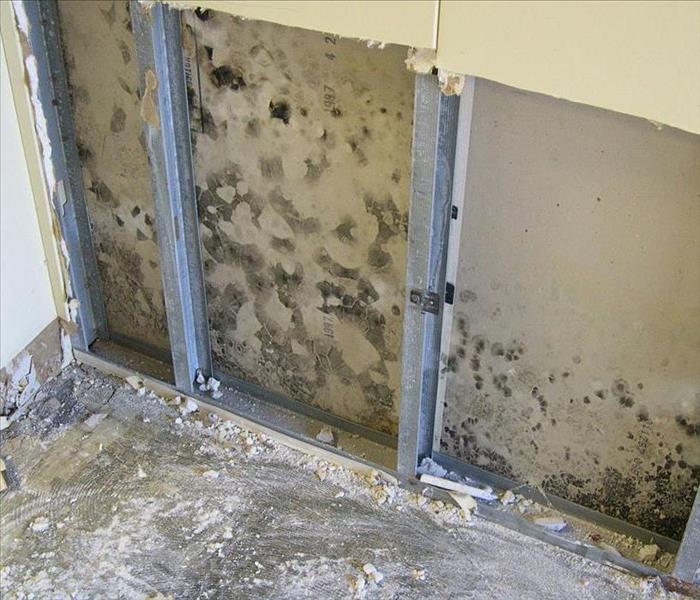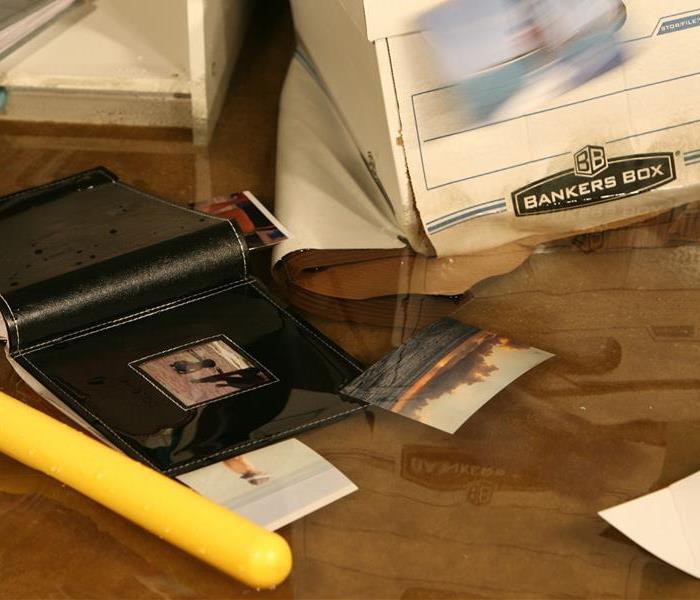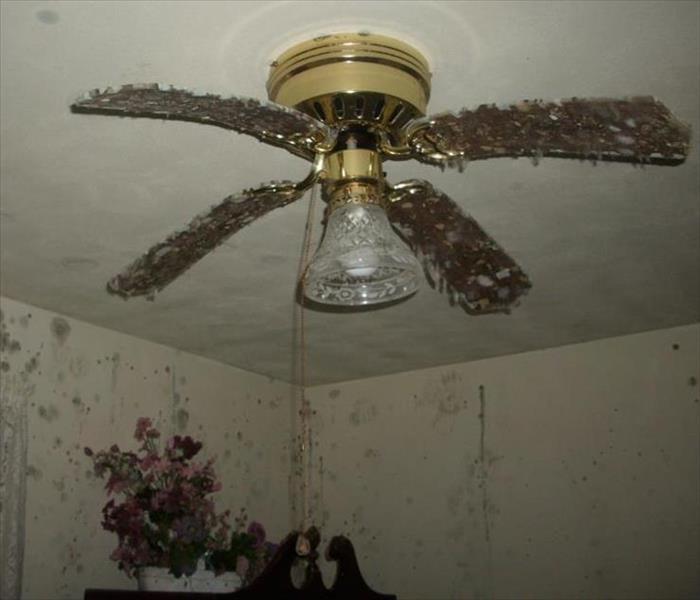Recent Mold Remediation Posts
Controlling Moisture in Your Home
9/29/2021 (Permalink)
Extra moisture in your Franklin County, MO home can cause damage and encourage potentially harmful mold and mildew growth.
How can you reduce moisture in your home? Learn to keep moisture out and prevent damage and mold.
Activities such as cooking, bathing, and dish washing can add moisture into the air. Even some heating appliances can cause additional humidity in your home, for example: unvented gas or kerosene models. Droplets can accumulate on common cool surfaces during the winter, such as windows, walls, and doors that lack proper insulation. This can cause rot and peeling of paint and is a good environment for mold growth.
If you happen to see moisture accumulating, be sure to dry it promptly. Be sure to take care of the issue that is causing the moisture.
Storm doors and windows can minimize cool surfaces in the winter by separating the interior from cold air outside. Upgrading your windows to double and triple pane can also help insulate the interior glass. This will also make your home more energy efficient.
Opening drapes and blinds in the winter allows warmth to the interior glass. Some condensation can occur, but the improved circulation makes it less probable to accumulate. Insulating cold-water pipes eliminates a common cool surface.
Bathroom exhaust fans, dryer exhaust and ducted kitchen exhaust hoods that vent to the outside remove moisture that some activities create. Keep the devices free of dust, lint, grease or anything that could keep them from working efficiently.
Other ways to reduce air moisture:
•Covering pots while cooking, when possible
•Leaving room doors open to allow good air circulation
•Storing firewood outside
•Covering aquariums
Moisture in the home is not always as obvious as water beading on a window. Poor ventilation in an attic can result in condensation, promoting mold growth in the framing elements of the house. A sealed, unused fireplace creates an opportunity for moisture problems. If air doesn't circulate in the fireplace, condensation can accumulate on the walls and soak into the masonry. If you have a crawlspace, moisture from the soil can enter your home, increasing the level of humidity. A vapor barrier over the bare soil blocks the moisture.
Rain that seeps into your home's foundation can lead to moisture problems. Make sure your gutters work properly and direct water away from your home's foundation.
Some moisture problems require more complex solutions, and sources of moisture may be hidden. It may be time to call a professional like SERVPRO. Extra moisture in your home can cause mold. Mold can produce allergens and irritants so if you suspect you have a mold issue, you should call us to inspect your Franklin County, MO home. We are trained mold damage specialists who get started quickly to get your Franklin County, MO home (or business) back to normal, with specific training and certifications to handle your restoration needs.
If You See Signs of Mold, Call Us Today – (636) 583-5200
How to Deal With Spring Mold
4/22/2021 (Permalink)
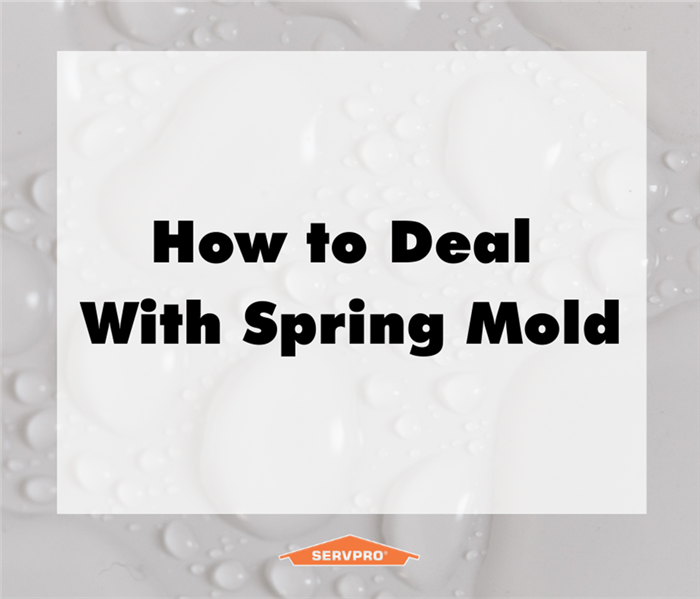 If you have mold problems, call SERVPRO of Franklin County. We are here to help.
If you have mold problems, call SERVPRO of Franklin County. We are here to help.
Anyone with bad allergies will tell you that spring is the worst time for mold.
Why is this the case?
Well, it turns out that April showers don’t just bring May flowers. Spring rain can cause mold to bloom, as moisture in the air jumpstarts its growth.
While mold can be a detriment to your allergies, it can also make an impact on your home. So what can you do to prevent mold from spreading this spring?
- Use Fans to Create Air Flow
It’s important to get air circulating throughout your home. When there is air flow, mold never gets a chance to settle on surfaces, windows or walls. It’s recommended to use exhaust fans in the kitchen while you’re cooking and large fans in the living room, bedrooms and basement.
Mold can’t form if there’s no moisture around. Make sure to dry clothes immediately after washing them and not leave them damp in the washing machine. Keep wet clothes and towels off the floor as well.
If you notice water seeping into your house, you’re at risk for mold growth. Seal any leaks you may have, and repair any damaged gutters so that rainwater flows away from your house rather than into the attic or foundation.
Keeping your air purified can stop mold from ever getting traction. HEPA filter air purifiers are especially effective in filtering out mold.
Mold can be a problem for both you and your home in the spring, but with a few precautions it can be prevented. However, if you are experiencing mold problems in your home, call the professionals at SERVPRO of Franklin County for mitigation.
Defense Against Mold Growth
8/4/2020 (Permalink)
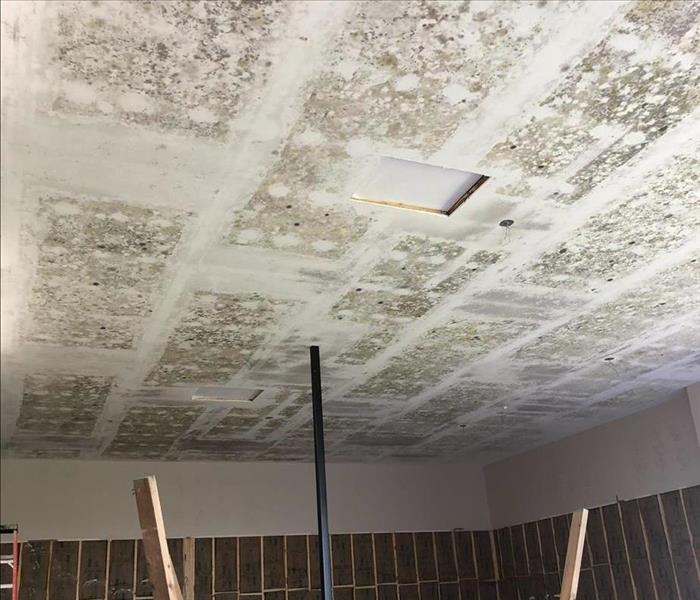 If you discover mold in your home or business, give SERVPRO of Franklin County a call.
If you discover mold in your home or business, give SERVPRO of Franklin County a call.
Prompt mitigation is vital to avoid mold growth, which can be visible in as little as 24 to 48 hours under certain conditions.
Here are some tips to keep your home safe from mold growth:
- Keep the humidity between 30 to 60 percent.
- Provide for proper drainage away from building foundations.
- Regularly inspect plumbing and appliances for leaks.
- Keep gutters and drains clear of debris.
- Inspect the roof, windows, and other areas where water might enter the building and perform necessary maintenance.
- Respond to all water intrusions immediately.
Contact SERVPRO® of Franklin County for assistance after a water damage or if you discover mold.
We are here to help: 636-583-5200.
Mold Damage as a Realtor
7/7/2019 (Permalink)
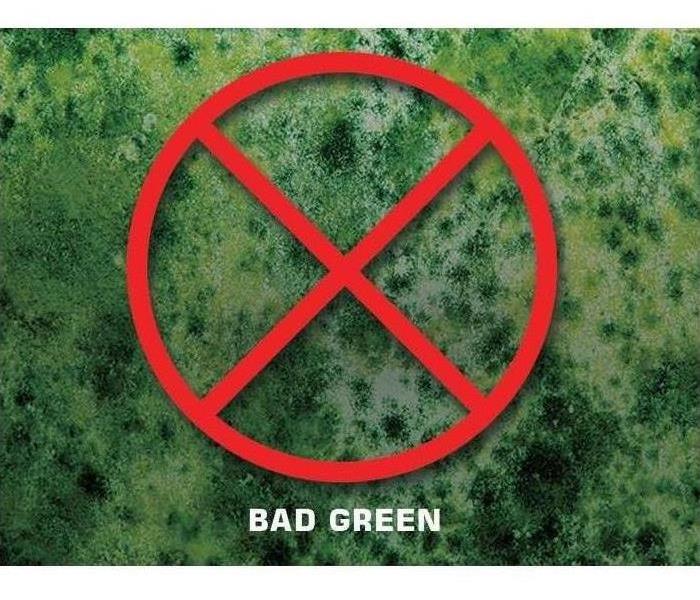 Mold damage as a realtor
Mold damage as a realtor
Realtors: Dealing with Mold
Mold Remediation Approved
Mold Remediation for realtors - Call SERVPRO6/22/2018
As a realtor, you work hard at finding people a place they can call home. You also work hard at presenting less-than-desirable houses in a way that suddenly appears like home to someone else. In doing so, sometimes mold is one of the battles you pursue. At SERVPRO of Franklin County, we want to help you.
Be an Informed Resource
Molds are found in every environment, and mold spores reduce rapidly when moisture is present. An Institute of Medicine study found excessive dampness indoors encourages the growth of molds and other organisms, causing a public health problem. The EPA advised that the potential health concerns from molds are an important reason to prevent moisture problems leading to mold growth. It is especially important to clean up existing indoor mold growth to increase property appeal and retain its value. If a property has experienced a water intrusion, SERVPRO of Franklin County can inspect the damage to see whether moisture has penetrated materials or is allowing mold growth.
Control Moisture - Reduce Mold
Prior to listing a property, the following steps can be taken to reduce the potential for moisture buildup or mold growth. Should a damage event occur, timely response is the key to preventing further damage--act within the first 24 to 48 hours.
- Correct any water leaks or standing water
- Remove standing water under cooling coils or air handling units
- Properly maintain humidifiers, if used
- Replace wet or visibly moldy insulation materials
- Steam cleaning and other methods involving moisture should not be used on any kind of duct work
- Install a ventilation system
If you suspect a listing has mold damage, we can help you. Give us a call to hear more about our mold remediation services. 636-583-5200
Mold Damage in Washington, MO
7/2/2019 (Permalink)
 Washington MO, Mold Damage Mitigation
Washington MO, Mold Damage Mitigation
Professional Mold Damage Remediation in Washington, MO
All it takes is excess humidity or a small water leak for mold damage in Washington, MO to form in your home or business. Mold spores can produce harmless allergens, irritants, and other minor health effects. The first step in addressing any growth is to identify and manage the source. If moisture problems are not addressed, then any fungi cleanup or removal will only be a short-term solution. At some point, this type of growth will return.
Here are some interesting mold facts and myths
- How many types of mold are there?
There are more than 100,000 types and species of mold. The common types of home and office mold species are Cladosporium, Penicillium, Aspergillus, and Alternaria.
• Can mold can only grow around pipes, leaks or because of floods?
Mold does not grow on surfaces that are directly affected by water. Mold spores often occur within the HVAC systems of buildings and homes. They can grow on any surface that has its ideal environment, moisture, and humidity.
• Is black mold worse than other molds?
Mold growth comes in a range of colors. Many molds classified black are actually a very dark green. Black mold is not necessarily more dangerous than other species of mold.
• Can this fungus cause skin rashes?
The CDC reports that exposure to molds doesn’t contribute to rashes.
• Can I clean mold to eliminate it?
Mold can become latent and reactivate. Tiny mold spores replicate every 24 hours, thus often growing back. For porous materials, like ceiling tiles, carpeting, wood, paper, and drywall, surface cleaning is often not enough.
If you see signs of mold damage in your Washington, MO home or business don't put out the for sale sign.
Instead, contact SERVPRO of Franklin County. As a trusted leader in the restoration industry, SERVPRO of Franklin County provides 24-hour residential and commercial services.
As a locally owned and operated business, we’re dedicated to being faster to any size disaster, with the training, equipment, and expertise to handle your restoration and cleaning needs.
If you would like to schedule service for your home or business, please call today! 636-583-5200
Professional Mold Damage Remediation in Washington, MO
6/12/2019 (Permalink)
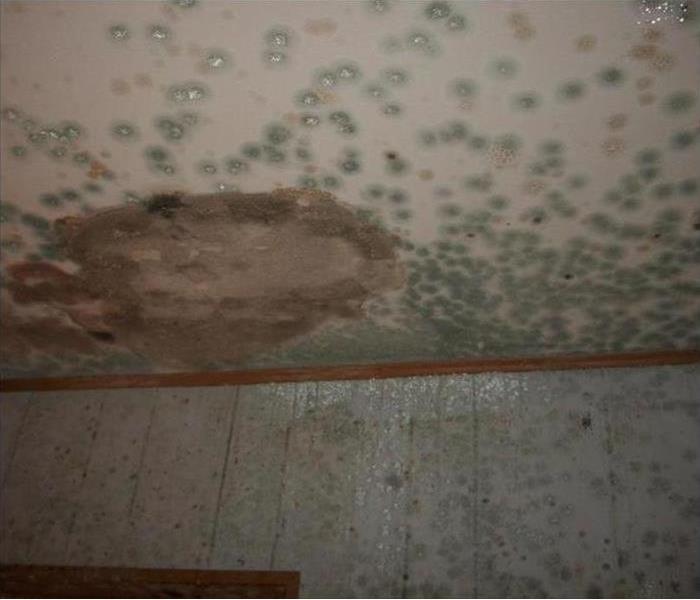 Mold Damage in Union, MO
Mold Damage in Union, MO
All it takes is excess humidity or a small water leak for mold damage in Union, MO to form in your home or business. Mold spores can produce harmless allergens, irritants, and other minor health effects. The first step in addressing any growth is to identify and manage the source. If moisture problems are not addressed, then any fungi cleanup or removal will only be a short-term solution. At some point, this type of growth will return.
Here are some interesting mold facts and myths:
• How many types of mold are there? There are more than 100,000 types and species of mold. The common types of home and office mold species are Cladosporium, Penicillium, Aspergillus, and Alternaria.
• Can mold can only grow around pipes, leaks or because of floods? Mold does not grow on surfaces that are directly affected by water. Mold spores often occur within the HVAC systems of buildings and homes. They can grow on any surface that has its ideal environment, moisture, and humidity.
• Is black mold worse than other molds? Mold growth comes in a range of colors. Many molds classified black are actually a very dark green. Black mold is not necessarily more dangerous than other species of mold.
• Can this fungus cause skin rashes? The CDC reports that exposure to molds doesn’t contribute to rashes.
• Can I clean mold to eliminate it? Mold can become latent and reactivate. Tiny mold spores replicate every 24 hours, thus often growing back. For porous materials, like ceiling tiles, carpeting, wood, paper, and drywall, surface cleaning is often not enough.
If you see signs of mold damage in your Washington, MO home or business don't put out the for sale sign. Instead, contact SERVPRO of Franklin County. As a trusted leader in the restoration industry, SERVPRO of Franklin County provides 24-hour residential and commercial services. As a locally owned and operated business, we’re dedicated to being faster to any size disaster, with the training, equipment, and expertise to handle your restoration and cleaning needs.
If you would like to schedule service for your home or business, please call today! 636-583-5200
Mold Basics
2/1/2019 (Permalink)
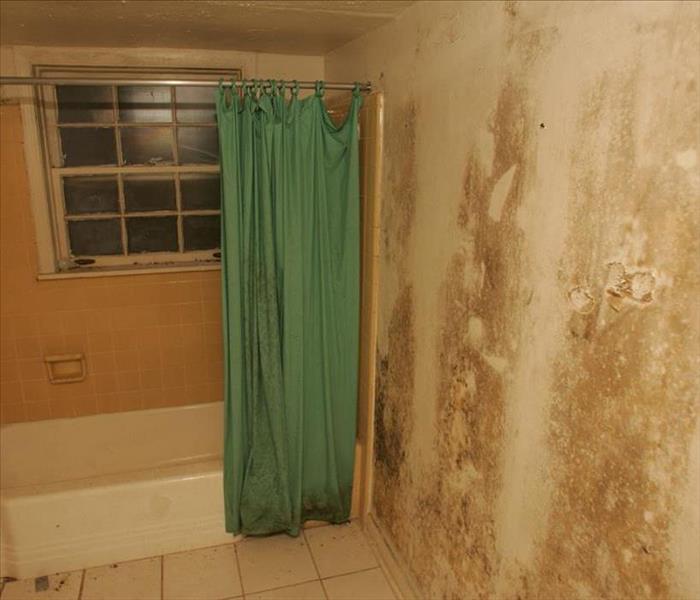 Mold Damage Franklin County, MO
Mold Damage Franklin County, MO
Moisture Control: The key to mold control.
If you find a mold problem in your home, you should fix the water problem and clean up the mold promptly.
Typically, mold can grow in 24/48 hours. That is why it is important to dry water-damaged areas as soon as possible.
Why is mold growing in my home?
Molds are part of the natural environment. Outdoors, molds play a part in nature by breaking down dead organic matter such as fallen leaves and dead trees, but indoors, mold growth should be avoided. Molds reproduce by means of tiny spores; the spores are invisible to the naked eye and float through outdoor and indoor air. There are many types of mold, and none of them will grow without water or moisture.
Moisture and Mold Prevention and Control Tips
- When water leaks or spills occur indoors - ACT QUICKLY. If wet or damp materials or areas are dried 24-48 hours after a leak or spill happens, in most cases mold will not grow.
- Clean and repair roof gutters regularly.
- Make sure the ground slopes away from the building foundation, so that water does not enter or collect around the foundation.
- Keep air-conditioning drip pans clean and the drain lines unobstructed and flowing properly.
- Keep indoor humidity low. If possible, keep indoor humidity below 60 percent (ideally between 30 and 50 percent) relative humidity. Relative humidity can be measured with moisture or humidity meter, a small, inexpensive ($10-$50) instrument available at many hardware stores.
- If you see condensation or moisture collecting on windows, walls or pipes ACT QUICKLY to dry the wet surface and reduce the moisture/water source. Condensation can be a sign of high humidity.
Bathroom Tip
Places that are often or always damp can be hard to maintain completely free of mold. If there’s some mold in the shower or elsewhere in the bathroom that seems to reappear, increasing ventilation (running a fan or opening a window) and cleaning more frequently will usually prevent mold from recurring, or at least keep the mold to a minimum.
Any home or commercial property can quickly become infested with mold if a source of water is present.
Mold can spread throughout a property in as little as 48 hours. Since mold can produce allergens and irritants, you should call us to inspect your Union home if you suspect you have a mold problem. If mold is found, we have the training, equipment, and expertise to remediate your mold infestation.
Learn more about mold and what to do until help arrives by reviewing these mold damage tips.
If You See Signs of Mold, Call Us Today – (636) 583-5200
Mold in your Sullivan, MO home or business
7/18/2018 (Permalink)
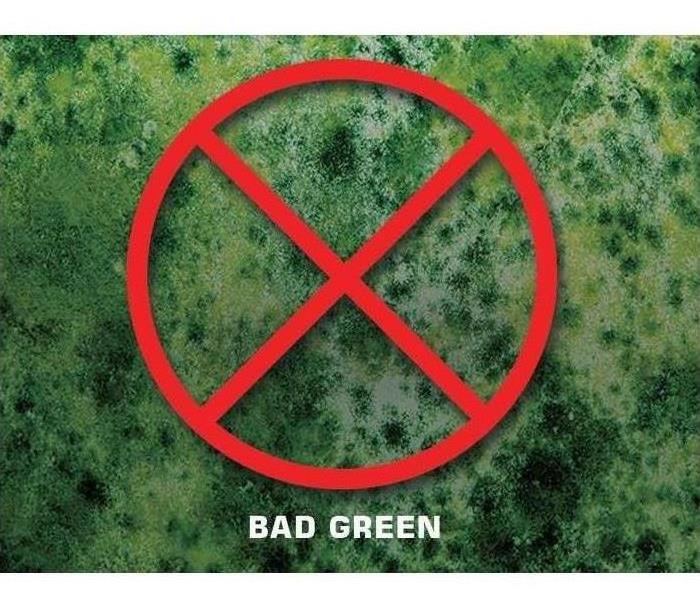 Mold Damage Sullivan, MO
Mold Damage Sullivan, MO
Do you suspect mold in your Union, MO home or business?
A green fuzzy film on the wall or a stale musty smell. These are all signs that your house or business probably has mold.
When someone suspects mold we suggest a visual inspection first. In addition we will use our moisture meters to search for a moisture source. Often we are successful with this method in identifying the existence of mold and the proper remediation plan. If a visual inspection is not successful or the situation requires additional confirmation we can test for mold. The most common method of testing is air sampling. A canister traps air and than is tested by the lab. This will determine the existence of mold, the amount of mold, and the type of mold. In addition swab or tape lift samples can be taken which are helpful In identifying mold in a more focused or central area. The down side to testing is it can be expensive. Outside testing firms charge at a minimum between $800-$1500. We charge considerably less but it still can be costly.
Once mold has been identified either visually or by test, a mitigation protocol is developed. The protocol outlines the remediation work to be done and the areas that are affected. The protocol is usually followed to the letter. The first protocol requirement is always to set up containment. Heavy 6 mil plastic is used to contain the affected area and protect the unaffected area. Next we place the affected area under negative pressure with air scrubbers. This creates a sort of vacuum keeping stray mold spores from affecting other areas. Later those same air scrubbers are used to scrub the air. Since most porous items cannot be effectively cleaned, they are removed and properly disposed of. An example of porous household items would be carpet, pad, drywall, insulation , upholstered items, mattress, stuffed animals, etc. Porous items can only be cleaned on the surface and mold roots can burrow deeper making it impossible to completely remove all of the mold.
After all of the porous items are removed we can focus on the cleanable non porous items. Some examples of non porous household items are subfloor, hard flooring, floor joists, wall studs, concrete walls and floors, wood furniture, etc. Under negative pressure all of these items are HEPPA vacuumed than cleaned with a EPA approved disinfectant. A lot of time the affected areas will need to be agitated using brushes, sanders, or even multimedia machines such as ice or soda blasting. This ensures that the mold and its root are removed. The process is HEPPA Vacuum, clean and repeat. Usually this process repeats at least three times. Remember this is all performed in contained areas, under negative pressure by highly trained crew members wearing personal protection equipment such as protective suits, eye protection and respirators.
Once the structure and any non porous items are properly cleaned usually the hvac system and air ducts are cleaned. This prevents contaminants from being recirculated throughout the newly remediated building. Lastly as a preventative option, the structure can be sealed with a EPA approved sealer/mold inhibitor. The sealer serves as a final protection against the reoccurrence of mold.
Next to the question “Do I have mold?”, the most popular question is “How much is it going to cost to remove the mold?” The answer is not so simple.
Because every situation is unique there is no square foot price for estimating. Every job has to be inspected and uniquely estimated. On every job we must determine how much labor, how much equipment, how much chemical
and if any specialized equipment or final testing would be required. Based on these factors we put together a time and material estimate and present it to the customer making sure they have a full understanding of what to expect.
Hopefully this short article spreads some light on the mysteries of mold and mold remediation.
If you or your client suspects mold, don’t let it continue to grow. Give us a call we would be happy to inspect, test and provide a estimate if necessary.
Realtors: Dealing with Mold
6/22/2018 (Permalink)
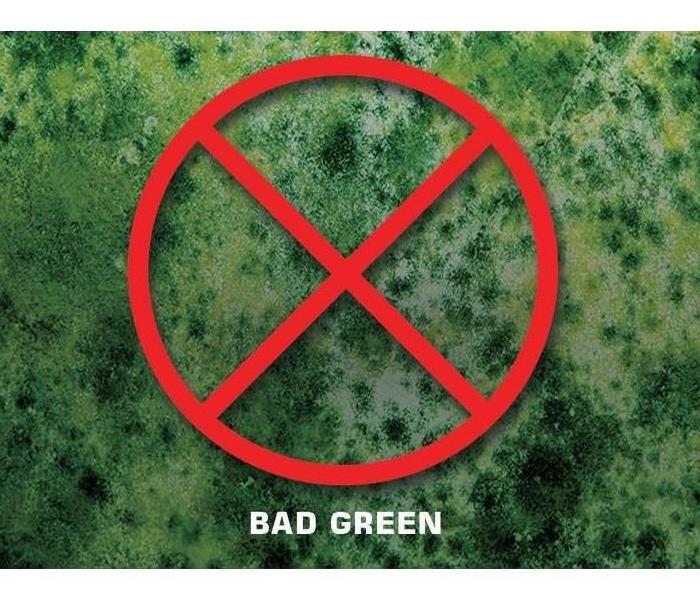 Mold Remediation for realtors - Call SERVPRO
Mold Remediation for realtors - Call SERVPRO
As a realtor, you work hard at finding people a place they can call home. You also work hard at presenting less-than-desirable houses in a way that suddenly appears like home to someone else. In doing so, sometimes mold is one of the battles you pursue. At SERVPRO of Franklin County, we want to help you.
Be an Informed Resource
Molds are found in every environment, and mold spores reduce rapidly when moisture is present. An Institute of Medicine study found excessive dampness indoors encourages the growth of molds and other organisms, causing a public health problem. The EPA advised that the potential health concerns from molds are an important reason to prevent moisture problems leading to mold growth. It is especially important to clean up existing indoor mold growth to increase property appeal and retain its value. If a property has experienced a water intrusion, SERVPRO of Franklin County can inspect the damage to see whether moisture has penetrated materials or is allowing mold growth.
Control Moisture - Reduce Mold
Prior to listing a property, the following steps can be taken to reduce the potential for moisture buildup or mold growth. Should a damage event occur, timely response is the key to preventing further damage--act within the first 24 to 48 hours.
- Correct any water leaks or standing water
- Remove standing water under cooling coils or air handling units
- Properly maintain humidifiers, if used
- Replace wet or visibly moldy insulation materials
- Steam cleaning and other methods involving moisture should not be used on any kind of duct work
- Install a ventilation system
If you suspect a listing has mold damage, we can help you. Just give us a call to hear more about our mold remediation services. 636-583-5200
What You Need To Know About Mold
6/7/2018 (Permalink)
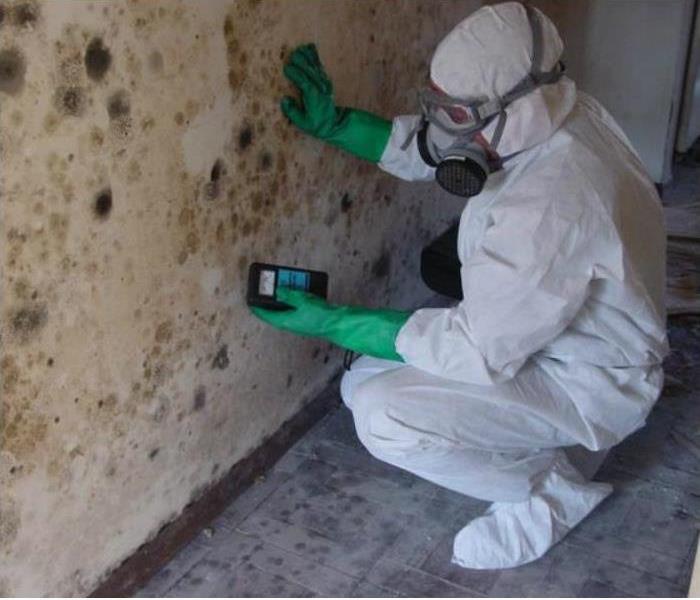 Mold Damage Franklin County, MO
Mold Damage Franklin County, MO
Ten Things To Know About Mold
- Potential health effects and symptoms associated with mold exposures include allergic reactions, asthma and other respiratory complaints.
- There is no practical way to eliminate all mold and mold spores in the indoor environment; the way to control indoor mold growth is to control moisture.
- If mold is a problem in your home or school, you must clean up the mold and eliminate sources of moisture.
- Fix the source of the water problem or leak to prevent mold growth.
- Reduce indoor humidity (to 30-60%) to decrease mold growth by:
-Venting bathrooms, dryers and other moisture-generating sources to the outside
-Using air conditioners and de-humidifiers
-Increasing ventilation
-Using exhaust fans whenever cooking, dishwashing and cleaning - Clean and dry any damp or wet building materials and furnishings within 24-48 hours to prevent mold growth.
- Clean mold off hard surfaces with water and detergent, and dry completely. Absorbent materials such as ceiling tiles, that are moldy, may need to be replaced.
- Prevent condensation: Reduce the potential for condensation on cold surfaces (i.e., windows, piping, exterior walls, roof, or floors) by adding insulation.
- In areas where there is a perpetual moisture problem, do not install carpeting (i.e., by drinking fountains, by classroom sinks, or on concrete floors with leaks or frequent condensation).
- Molds can be found almost anywhere; they can grow on virtually any substance, providing moisture is present. There are molds that can grow on wood, paper, carpet, and foods.
Source: cdc.gov/mold
The Mold Remediation Process
Every mold infestation is different, from the amount of mold to the types of materials affected. Each scenario requires a unique solution, but the general process stays the same. The steps listed below illustrate The SERVPRO of Franklin County process for a “typical” mold remediation infestation:
- Emergency Contact - (636) 583-5200
- Inspection and Mold Damage Assessment
- Mold Containment
- Air Filtration
- Removing Mold and Mold-Infested Materials
- Cleaning Contents and Belongings
- Restoration
Common Mold Misconceptions
It’s easy to understand why many people struggle to grasp the facts and issues surrounding indoor mold because sensational news stories and advertising cloud and obscure the real issues. Educate yourself with the facts about mold and learn about the mold remediation process.
Locally Owned Company with National Resources
We live and work in this community too; we might even be neighbors. As a locally owned and operated business, SERVPRO of Franklin County is close by and ready to help with your mold-damaged property. We are proud to be an active member of the Franklin County, MO community and want to pitch in and help make our community the best it can be.
Washington, MO Professional Mold Damage
6/7/2018 (Permalink)
 Washington, MO Mold Damage
Washington, MO Mold Damage
Professional Mold Damage Remediation in Washington, MO
All it takes is excess humidity or a small water leak for mold damage in Washington, MO to form in your home or business. Mold spores can produce harmless allergens, irritants, and other minor health effects. The first step in addressing any growth is to identify and manage the source. If moisture problems are not addressed, then any fungi cleanup or removal will only be a short-term solution. At some point, this type of growth will return.
Here are some interesting mold facts and myths:
• How many types of mold are there? There are more than 100,000 types and species of mold. The common types of home and office mold species are Cladosporium, Penicillium, Aspergillus, and Alternaria.
• Can mold can only grow around pipes, leaks or because of floods? Mold does not grow on surfaces that are directly affected by water. Mold spores often occur within the HVAC systems of buildings and homes. They can grow on any surface that has its ideal environment, moisture, and humidity.
• Is black mold worse than other molds? Mold growth comes in a range of colors. Many molds classified black are actually a very dark green. Black mold is not necessarily more dangerous than other species of mold.
• Can this fungus cause skin rashes? The CDC reports that exposure to molds doesn’t contribute to rashes.
• Can I clean mold to eliminate it? Mold can become latent and reactivate. Tiny mold spores replicate every 24 hours, thus often growing back. For porous materials, like ceiling tiles, carpeting, wood, paper, and drywall, surface cleaning is often not enough.
If you see signs of mold damage in your Washington, MO home or business don't put out the for sale sign. Instead, contact SERVPRO of Franklin County. As a trusted leader in the restoration industry, SERVPRO of Franklin County provides 24-hour residential and commercial services. As a locally owned and operated business, we’re dedicated to being faster to any size disaster, with the training, equipment, and expertise to handle your restoration and cleaning needs. If you would like to schedule service for your home or business, please call today! 636-583-5200
What Mold Specialists Do After a Flood
5/31/2018 (Permalink)
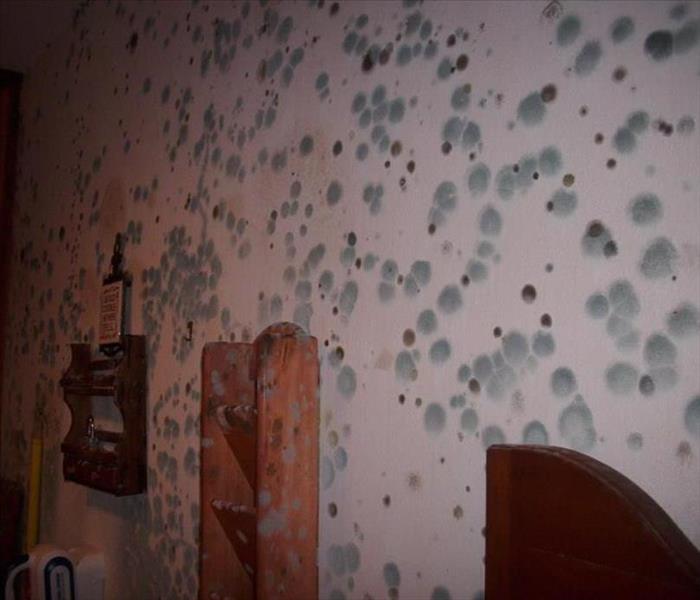 Mold Damage Franklin County MO
Mold Damage Franklin County MO
Have you ever wondered what happens when a mold removal specialist gets called to a mold-damaged facility? The Institute of Inspection, Cleaning and Restoration Certification (IICRC) shares below five steps a mold-removal specialist takes when conducting mold remediation.“Many people aren’t aware of the dangers or the difficulty level of removing mold from a facility,” said IICRC Chairman Tony Wheelwright. “Mold remediation is a potentially hazardous process that should only be undertaken by a certified professional.”
Five steps each mold-removal specialist takes when conducting mold remediation include:
1. Determine the degree of contamination
The first step for a mold remediation specialist may be to bring in an Indoor Environmental Professional (IEP) to determine the extent of the mold damage and test for contamination within the facility.
Because mold spores and other microscopic contaminants can travel easily throughout a building, the IEP may collect and analyze samples from affected, as well as unaffected, areas of the building. Once the IEP has finished the inspection they will develop a remediation plan for the mold-removal specialist with steps to return the home to its preloss condition (Condition 1).
2. Set up and verify the containment
To make sure mold contamination does not spread to other areas of a facility, the mold-remediation specialist will set up containment by creating isolation barriers.
Once the barriers are set up, the specialist will need to verify the containment with a lower partial pressure differential (negative pressure) to ensure there is no air leakage between containment zones.
Exit chambers will then be used to serve as a transition between the containment and the unaffected area of the building. Once the containment is verified and the correct amount of pressure is achieved, the removal process can begin.
3. Remove unsalvageable materials
Porous materials and items that cannot be restored or cleaned effectively must be carefully discarded. Unsalvageable items include, but are not limited to, drywall, insulation and other items with visible mold growth.
It is important for the specialist to wear the appropriate personal protective equipment (PPE), which may include a full face respirator equipped with a P100/OV cartridge, disposable coveralls and nitrile gloves.
4. Clean surfaces with a high attention to detail
A mold-remediation specialist will likely begin the cleaning process by thoroughly vacuuming the contaminated areas using a HEPA vacuum with a high efficiency filter to catch mold spores. He or she will then begin a detailed cleaning process involving mold removal tools such as a HEPA-filtered sander followed by the damp wiping of surfaces with an effective cleaning solution.
5. Verify remediation
Once cleaning is complete, the IEP will return to verify the remediation was successful. The area must be returned to the dry standard and should be visually dust free with no malodors.
In addition, an IEP may perform surface or air sampling as part of the verification that the area is back to normal fungal ecology (Condition 1).
“Mold remediation requires mold removal specialists to perform techniques that promote source removal rather than relying on chemicals, paints and coatings as a replacement,” said Rachel Adams, President of Indoor Environmental Management Inc. “Understanding and managing air flow is also critical to the success of a mold remediation project. Working with qualified IEP can also help to reduce the liability for the technician as well as provide a final determination if the remediation was successful.”
Source: http://www.IICRC.org
Mold In Your Franklin County, MO Home or Business
2/1/2018 (Permalink)
 Franklin County, MO Mold Damage Remediation
Franklin County, MO Mold Damage Remediation
A green fuzzy film on the wall or a stale musty smell. These are all signs that your house or business probably has mold.
When someone suspects mold we suggest a visual inspection first. In addition we will use our moisture meters to search for a moisture source. Often we are successful with this method in identifying the existence of mold and the proper remediation plan. If a visual inspection is not successful or the situation requires additional confirmation we can test for mold. The most common method of testing is air sampling. A canister traps air and than is tested by the lab. This will determine the existence of mold, the amount of mold, and the type of mold. In addition swab or tape lift samples can
be taken which are helpful In identifying mold in a more focused or central area. The down side to testing is it can be expensive. Outside testing firms charge at a minimum between $800-$1500. We charge considerably less
but it still can be costly.
Once mold has been identified either visually or by test, a mitigation protocol is developed. The protocol outlines the remediation work to be done and the areas that are affected. The protocol is usually followed to the letter. The first protocol requirement is always to set up containment. Heavy 6 mil
plastic is used to contain the affected area and protect the unaffected area. Next we place the affected area under negative pressure with air scrubbers. This creates a sort of vacuum keeping stray mold spores from affecting other areas. Later those same air scrubbers are used to scrub the air. Since most porous items cannot be effectively cleaned, they are removed and properly disposed of. An example of porous household items would be carpet, pad, drywall, insulation , upholstered items, mattress, stuffed animals, etc. Porous items can only be cleaned on the surface and mold roots can
burrow deeper making it impossible to completely remove all of the mold.
After all of the porous items are removed we can focus on the cleanable non porous items. Some examples of non porous household items are subfloor, hard flooring, floor joists, wall studs, concrete walls and floors, wood
furniture, etc. Under negative pressure all of these items are HEPPA vacuumed than cleaned with a EPA approved disinfectant. A lot of time the affected areas will need to be agitated using brushes, sanders, or even multimedia machines such as ice or soda blasting. This ensures that the mold and its root are removed. The process is HEPPA Vacuum, clean and repeat. Usually this process repeats at least three times. Remember this is all performed in contained areas, under negative pressure by highly trained crew members wearing personal protection equipment such as protective suits, eye protection and respirators.
Once the structure and any non porous items are properly cleaned usually the hvac system and air ducts are cleaned. This prevents contaminants from being recirculated throughout the newly remediated building. Lastly
as a preventative option, the structure can be sealed with a EPA approved sealer/mold inhibitor. The sealer serves as a final protection against the reoccurrence of mold.
Next to the question “Do I have mold?”, the most popular question is “How much is it going to cost to remove the mold?” The answer is not so simple.
Because every situation is unique there is no square foot price for estimating. Every job has to be inspected and uniquely estimated. On every job we must determine how much labor, how much equipment, how much chemical
and if any specialized equipment or final testing would be required. Based on these factors we put together a time and material estimate and present it to the customer making sure they have a full understanding of what to expect.
Hopefully this short article spreads some light on the mysteries of mold and mold remediation.
If you or your client suspects mold, don’t let it continue to grow. Give us a call we would be happy to inspect, test and provide a estimate if necessary.
Mold in your Union, MO home or business
1/8/2018 (Permalink)
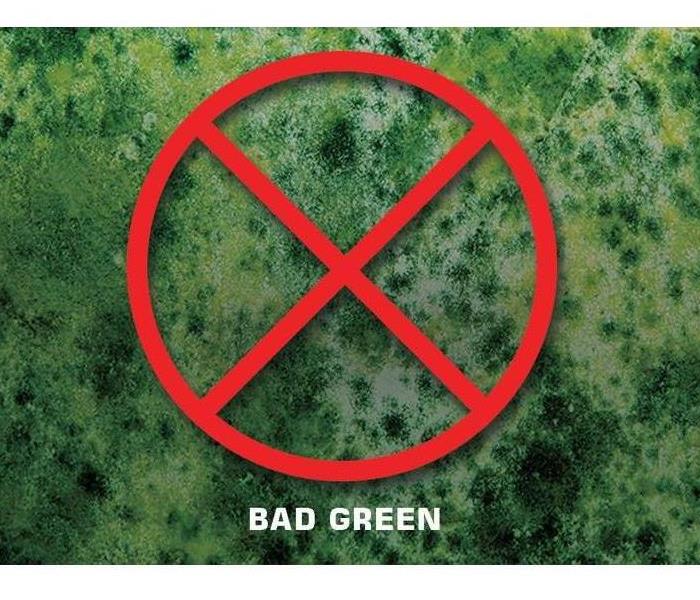 Mold remediation Franklin County, MO
Mold remediation Franklin County, MO
Do you suspect mold in your Union, MO home or business?
A green fuzzy film on the wall or a stale musty smell. These are all signs that your house or business probably has mold.
When someone suspects mold we suggest a visual inspection first. In addition we will use our moisture meters to search for a moisture source. Often we are successful with this method in identifying the existence of mold and the proper remediation plan. If a visual inspection is not successful or the situation requires additional confirmation we can test for mold. The most common method of testing is air sampling. A canister traps air and than is tested by the lab. This will determine the existence of mold, the amount of mold, and the type of mold. In addition swab or tape lift samples can be taken which are helpful In identifying mold in a more focused or central area. The down side to testing is it can be expensive. Outside testing firms charge at a minimum between $800-$1500. We charge considerably less but it still can be costly.
Once mold has been identified either visually or by test, a mitigation protocol is developed. The protocol outlines the remediation work to be done and the areas that are affected. The protocol is usually followed to the letter. The first protocol requirement is always to set up containment. Heavy 6 mil plastic is used to contain the affected area and protect the unaffected area. Next we place the affected area under negative pressure with air scrubbers. This creates a sort of vacuum keeping stray mold spores from affecting other areas. Later those same air scrubbers are used to scrub the air. Since most porous items cannot be effectively cleaned, they are removed and properly disposed of. An example of porous household items would be carpet, pad, drywall, insulation , upholstered items, mattress, stuffed animals, etc. Porous items can only be cleaned on the surface and mold roots can burrow deeper making it impossible to completely remove all of the mold.
After all of the porous items are removed we can focus on the cleanable non porous items. Some examples of non porous household items are subfloor, hard flooring, floor joists, wall studs, concrete walls and floors, wood furniture, etc. Under negative pressure all of these items are HEPPA vacuumed than cleaned with a EPA approved disinfectant. A lot of time the affected areas will need to be agitated using brushes, sanders, or even multimedia machines such as ice or soda blasting. This ensures that the mold and its root are removed. The process is HEPPA Vacuum, clean and repeat. Usually this process repeats at least three times. Remember this is all performed in contained areas, under negative pressure by highly trained crew members wearing personal protection equipment such as protective suits, eye protection and respirators.
Once the structure and any non porous items are properly cleaned usually the hvac system and air ducts are cleaned. This prevents contaminants from being recirculated throughout the newly remediated building. Lastly as a preventative option, the structure can be sealed with a EPA approved sealer/mold inhibitor. The sealer serves as a final protection against the reoccurrence of mold.
Next to the question “Do I have mold?”, the most popular question is “How much is it going to cost to remove the mold?” The answer is not so simple.
Because every situation is unique there is no square foot price for estimating. Every job has to be inspected and uniquely estimated. On every job we must determine how much labor, how much equipment, how much chemical
and if any specialized equipment or final testing would be required. Based on these factors we put together a time and material estimate and present it to the customer making sure they have a full understanding of what to expect.
Hopefully this short article spreads some light on the mysteries of mold and mold remediation.
If you or your client suspects mold, don’t let it continue to grow. Give us a call we would be happy to inspect, test and provide a estimate if necessary.
If You See Signs of Mold,
Call Us Today – (636) 583-5200
Why Is Mold And Mildew Such A Big Threat?
9/26/2017 (Permalink)
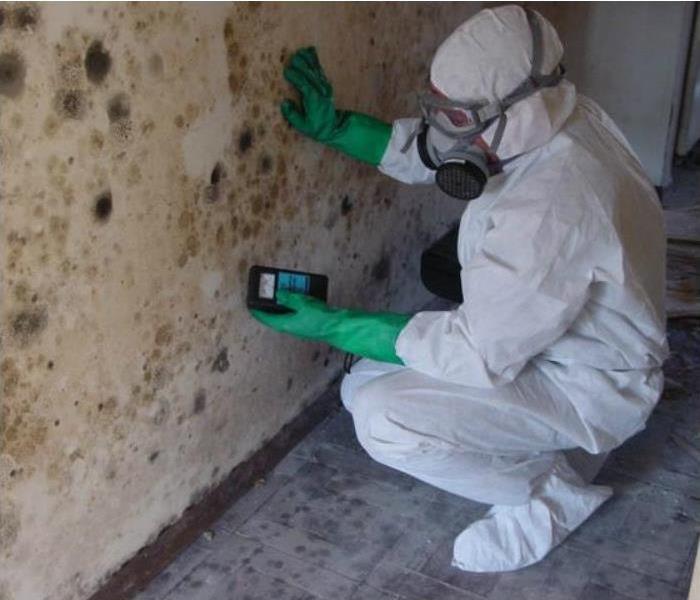 Mold Damage Restoration
Mold Damage Restoration
Mold and mildew are some of the most persistent enemies a homeowner can have, and getting rid of them for good can be a major hassle without professional assistance. Fungi is particularly stubborn in humid areas, though they can take root in any home that has issues with moisture buildup. All it takes is a slight, steady plumbing leak, or a slightly cracked window to give the fungi all the moisture and space it needs to operate. And once it shows up, it will spread quickly if not checked. This is why homeowners are often best served by seeking out certified professionals, as they will be able to completely eliminate the contamination without allowing it to spread.
The primary threat that mold and mildew produce is to the building inhabitants. Mold can produce allergens and irritants, and it has the potential to cause other health effects. This is especially problematic in young children and the elderly, who are susceptible to both. Fungi, though, can also destroy material and necessitate expensive replacements and repairs if not dealt with promptly.
Learn more about mold and what to do until help arrives by reviewing these mold damage tips.
If You See Signs of Mold, Call Us Today – (636) 583-5200
Source: http://www.IICRC.org/blog/
What You Need To Know About Mold
8/24/2017 (Permalink)
Ten Things To Know About Mold
- Potential health effects and symptoms associated with mold exposures include allergic reactions, asthma and other respiratory complaints.
- There is no practical way to eliminate all mold and mold spores in the indoor environment; the way to control indoor mold growth is to control moisture.
- If mold is a problem in your home or school, you must clean up the mold and eliminate sources of moisture.
- Fix the source of the water problem or leak to prevent mold growth.
- Reduce indoor humidity (to 30-60%) to decrease mold growth by:
-Venting bathrooms, dryers and other moisture-generating sources to the outside
-Using air conditioners and de-humidifiers
-Increasing ventilation
-Using exhaust fans whenever cooking, dishwashing and cleaning - Clean and dry any damp or wet building materials and furnishings within 24-48 hours to prevent mold growth.
- Clean mold off hard surfaces with water and detergent, and dry completely. Absorbent materials such as ceiling tiles, that are moldy, may need to be replaced.
- Prevent condensation: Reduce the potential for condensation on cold surfaces (i.e., windows, piping, exterior walls, roof, or floors) by adding insulation.
- In areas where there is a perpetual moisture problem, do not install carpeting (i.e., by drinking fountains, by classroom sinks, or on concrete floors with leaks or frequent condensation).
- Molds can be found almost anywhere; they can grow on virtually any substance, providing moisture is present. There are molds that can grow on wood, paper, carpet, and foods.
Source: cdc.gov/mold
The Mold Remediation Process
Every mold infestation is different, from the amount of mold to the types of materials affected. Each scenario requires a unique solution, but the general process stays the same. The steps listed below illustrate The SERVPRO of Franklin County process for a “typical” mold remediation infestation:
- Emergency Contact - (636) 583-5200
- Inspection and Mold Damage Assessment
- Mold Containment
- Air Filtration
- Removing Mold and Mold-Infested Materials
- Cleaning Contents and Belongings
- Restoration
Common Mold Misconceptions
It’s easy to understand why many people struggle to grasp the facts and issues surrounding indoor mold because sensational news stories and advertising cloud and obscure the real issues. Educate yourself with the facts about mold and learn about the mold remediation process.
Locally Owned Company with National Resources
We live and work in this community too; we might even be neighbors. As a locally owned and operated business, SERVPRO of Franklin County is close by and ready to help with your mold-damaged property. We are proud to be an active member of the Franklin County, MO community and want to pitch in and help make our community the best it can be.
What Mold Specialists Do After a Flood
6/7/2017 (Permalink)
Have you ever wondered what happens when a mold removal specialist gets called to a mold-damaged facility? The Institute of Inspection, Cleaning and Restoration Certification (IICRC) shares below five steps a mold-removal specialist takes when conducting mold remediation.
“Many people aren’t aware of the dangers or the difficulty level of removing mold from a facility,” said IICRC Chairman Tony Wheelwright. “Mold remediation is a potentially hazardous process that should only be undertaken by a certified professional.”
Five steps each mold-removal specialist takes when conducting mold remediation include:
1. Determine the degree of contamination
The first step for a mold remediation specialist may be to bring in an Indoor Environmental Professional (IEP) to determine the extent of the mold damage and test for contamination within the facility.
Because mold spores and other microscopic contaminants can travel easily throughout a building, the IEP may collect and analyze samples from affected, as well as unaffected, areas of the building. Once the IEP has finished the inspection they will develop a remediation plan for the mold-removal specialist with steps to return the home to its preloss condition (Condition 1).
2. Set up and verify the containment
To make sure mold contamination does not spread to other areas of a facility, the mold-remediation specialist will set up containment by creating isolation barriers.
Once the barriers are set up, the specialist will need to verify the containment with a lower partial pressure differential (negative pressure) to ensure there is no air leakage between containment zones.
Exit chambers will then be used to serve as a transition between the containment and the unaffected area of the building. Once the containment is verified and the correct amount of pressure is achieved, the removal process can begin.
3. Remove unsalvageable materials
Porous materials and items that cannot be restored or cleaned effectively must be carefully discarded. Unsalvageable items include, but are not limited to, drywall, insulation and other items with visible mold growth.
It is important for the specialist to wear the appropriate personal protective equipment (PPE), which may include a full face respirator equipped with a P100/OV cartridge, disposable coveralls and nitrile gloves.
4. Clean surfaces with a high attention to detail
A mold-remediation specialist will likely begin the cleaning process by thoroughly vacuuming the contaminated areas using a HEPA vacuum with a high efficiency filter to catch mold spores. He or she will then begin a detailed cleaning process involving mold removal tools such as a HEPA-filtered sander followed by the damp wiping of surfaces with an effective cleaning solution.
5. Verify remediation
Once cleaning is complete, the IEP will return to verify the remediation was successful. The area must be returned to the dry standard and should be visually dust free with no malodors.
In addition, an IEP may perform surface or air sampling as part of the verification that the area is back to normal fungal ecology (Condition 1).
“Mold remediation requires mold removal specialists to perform techniques that promote source removal rather than relying on chemicals, paints and coatings as a replacement,” said Rachel Adams, President of Indoor Environmental Management Inc. “Understanding and managing air flow is also critical to the success of a mold remediation project. Working with qualified IEP can also help to reduce the liability for the technician as well as provide a final determination if the remediation was successful.”
Source: http://www.IICRC.org
The Mold Mitigation & Remediation Process
5/31/2017 (Permalink)
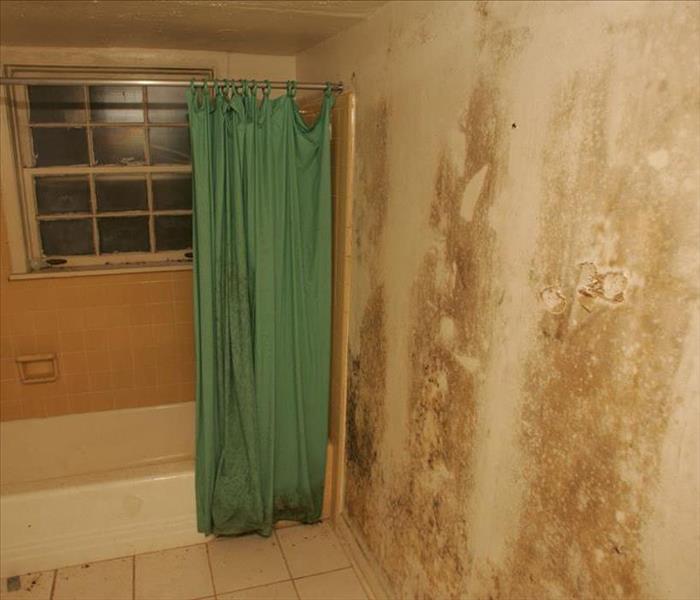 Mold Damage
Mold Damage
When there’s a water intrusion, like a roof leak or leaking water line, mold can quickly become a problem in your home or business. Mold can affect your health and can also cause significant damage to your property.
Fortunately, SERVPRO of Franklin County has the training, protective gear, and specialized equipment necessary to handle your mold problem. Although every mold damage scenario is different, requiring a unique solution, the general mold remediation process stays the same. The following steps illustrate a “typical” mold removal process.
Call SERVPRO of Franklin County
The mold cleanup and restoration process begins when you call SERVPRO. A representative will ask a series of questions to help determine the necessary equipment, resources, and personnel needed.
Inspection & Damage Assessment
Your property will be carefully inspected for signs of mold using technology designed to detect mold and hidden water sources. Mold feeds on cellulose and water which can be hidden from plain view.
Mold Containment
Various containment procedures will be placed to prevent the spread of mold and isolate the contaminated area with physical barriers and negative air pressure to keep the mold spores from spreading during the cleanup process.
Air Filtration
Specialized filtration equipment
captures microscopic mold spores out of the air. SERVPRO® technicians utilize powerful air scrubbers and HEPA vacuums to prevent the spread of these mold spores while the mold remediation is in progress.
Removing Mold & Mold-Infested Materials
The mold remediation process depends on the amount of mold growth and the types of surfaces on which the mold appears. Antifungal and antimicrobial treatments will be used to eliminate mold colonies and help prevent new colonies from forming. Removing and disposing of mold-infested porous materials, like drywall and flooring, may be necessary to remediate heavy mold growth.
Cleaning Contents & Belongings
SERVPRO® will clean your furniture, decorative items, curtains, and other restorable items affected by mold. They use a variety of cleaning techniques to clean and sanitize your belongings. They are also trained to remove odors and deodorize using fogging equipment.
Restoration
Depending on the level of mold damage, drywall, subfloors, and other building materials may be removed. Restoration may involve minor repairs, such as replacing drywall, painting, and installing new carpet, or it may entail major repairs such as the reconstruction of various areas or rooms in a home or business.
SERVPRO of Franklin County understand mold and mold growth and have the training and equipment to remediate mold in your home or business.
Why Is Mold And Mildew Such A Big Threat?
5/5/2017 (Permalink)
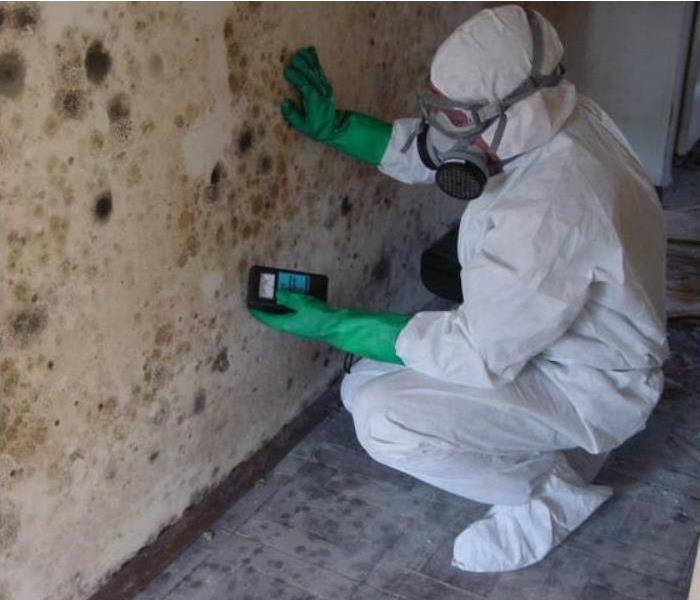 Mold Remediation and Restoration
Mold Remediation and Restoration
Mold and mildew are some of the most persistent enemies a homeowner can have, and getting rid of them for good can be a major hassle without professional assistance. Fungi is particularly stubborn in humid areas, though they can take root in any home that has issues with moisture buildup. All it takes is a slight, steady plumbing leak, or a slightly cracked window to give the fungi all the moisture and space it needs to operate. And once it shows up, it will spread quickly if not checked. This is why homeowners are often best served by seeking out certified professionals, as they will be able to completely eliminate the contamination without allowing it to spread.
The primary threat that mold and mildew produce is to the building inhabitants. Fungi contamination can aggravate allergies and respiratory conditions such as asthma. This is especially problematic in young children and the elderly, who are susceptible to both. Fungi, though, can also destroy material and necessitate expensive replacements and repairs if not dealt with promptly.
Remediation firms are experts at halting the spread of fungal contamination, and they know how to seal off the area to keep it from dispersing. And with their commercial grade products and processes, the contamination can be eliminated in short order. This quick response will minimize the damage and ensure the home is healthy enough for a family to live and relax in.
Any home or commercial property can quickly become infested with mold if a source of water is present. Mold can spread throughout a property in as little as 48 hours. Since mold can produce allergens and irritants, you should call us to inspect your Union home if you suspect you have a mold problem. If mold is found, we have the training, equipment, and expertise to remediate your mold infestation.
Learn more about mold and what to do until help arrives by reviewing these mold damage tips.
If You See Signs of Mold, Call Us Today – (636) 583-5200
Why Is Mold And Mildew Such A Big Threat?
2/2/2017 (Permalink)
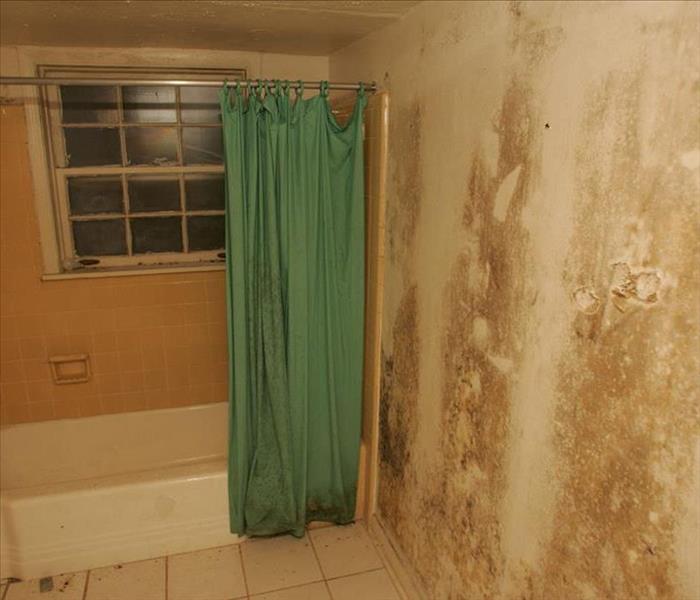 Mold Damage
Mold Damage
Mold and mildew are some of the most persistent enemies a homeowner can have, and getting rid of them for good can be a major hassle without professional assistance. Fungi is particularly stubborn in humid areas, though they can take root in any home that has issues with moisture buildup. All it takes is a slight, steady plumbing leak, or a slightly cracked window to give the fungi all the moisture and space it needs to operate. And once it shows up, it will spread quickly if not checked. This is why homeowners are often best served by seeking out certified professionals, as they will be able to completely eliminate the contamination without allowing it to spread.
Remediation firms are experts at halting the spread of fungal contamination, and they know how to seal off the area to keep it from dispersing. And with their commercial grade products and processes, the contamination can be eliminated in short order. This quick response will minimize the damage and ensure the home is healthy enough for a family to live and relax in.
The SERVPRO of Franklin County crew are trained mold damage specialists who get started quickly to get your home or business back to normal.
If You See Signs of Mold, Call Us Today – (636) 583-5200
Source: http://www.IICRC.org/
Mold
12/9/2016 (Permalink)
A green fuzzy film on the wall or a stale musty smell. These are all signs that your house or business probably has mold.
When someone suspects mold we suggest a visual inspection first. In addition we will use our moisture meters to search for a moisture source. Often we are successful with this method in identifying the existence of mold and the proper remediation plan. If a visual inspection is not successful or the situation requires additional confirmation we can test for mold. The most common method of testing is air sampling. A canister traps air and than is tested by the lab. This will determine the existence of mold, the amount of mold, and the type of mold. In addition swab or tape lift samples can
be taken which are helpful In identifying mold in a more focused or central area. The down side to testing is it can be expensive. Outside testing firms charge at a minimum between $800-$1500. We charge considerably less
but it still can be costly.
Once mold has been identified either visually or by test, a mitigation protocol is developed. The protocol outlines the remediation work to be done and the areas that are affected. The protocol is usually followed to the letter. The first protocol requirement is always to set up containment. Heavy 6 mil
plastic is used to contain the affected area and protect the unaffected area. Next we place the affected area under negative pressure with air scrubbers. This creates a sort of vacuum keeping stray mold spores from affecting other areas. Later those same air scrubbers are used to scrub the air. Since most porous items cannot be effectively cleaned, they are removed and properly disposed of. An example of porous household items would be carpet, pad, drywall, insulation , upholstered items, mattress, stuffed animals, etc. Porous items can only be cleaned on the surface and mold roots can
burrow deeper making it impossible to completely remove all of the mold.
After all of the porous items are removed we can focus on the cleanable non porous items. Some examples of non porous household items are subfloor, hard flooring, floor joists, wall studs, concrete walls and floors, wood
furniture, etc. Under negative pressure all of these items are HEPPA vacuumed than cleaned with a EPA approved disinfectant. A lot of time the affected areas will need to be agitated using brushes, sanders, or even multimedia machines such as ice or soda blasting. This ensures that the mold and its root are removed. The process is HEPPA Vacuum, clean and repeat. Usually this process repeats at least three times. Remember this is all performed in contained areas, under negative pressure by highly trained crew members wearing personal protection equipment such as protective suits, eye protection and respirators.
Once the structure and any non porous items are properly cleaned usually the hvac system and air ducts are cleaned. This prevents contaminants from being recirculated throughout the newly remediated building. Lastly
as a preventative option, the structure can be sealed with a EPA approved sealer/mold inhibitor. The sealer serves as a final protection against the reoccurrence of mold.
Next to the question “Do I have mold?”, the most popular question is “How much is it going to cost to remove the mold?” The answer is not so simple.
Because every situation is unique there is no square foot price for estimating. Every job has to be inspected and uniquely estimated. On every job we must determine how much labor, how much equipment, how much chemical
and if any specialized equipment or final testing would be required. Based on these factors we put together a time and material estimate and present it to the customer making sure they have a full understanding of what to expect.
Hopefully this short article spreads some light on the mysteries of mold and mold remediation.
If you or your client suspects mold, don’t let it continue to grow. Give us a call we would be happy to inspect, test and provide a estimate if necessary.
Mold Basics
11/21/2016 (Permalink)
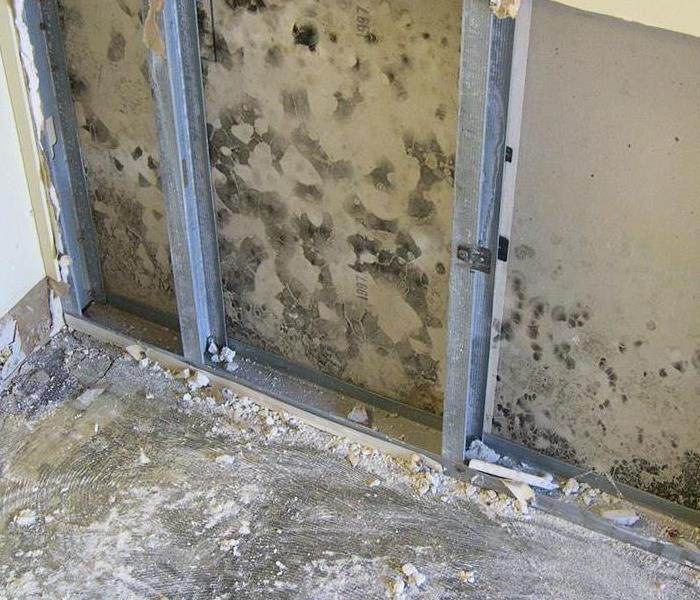 Mold Basics
Mold Basics
The key to mold control is moisture control.
-If mold is a problem in your home, you should clean up the mold promptly and fix the water problem.
-It is important to dry water-damaged areas and items within 24-48 hours to prevent mold growth.
Why is mold growing in my home?
Molds are part of the natural environment. Outdoors, molds play a part in nature by breaking down dead organic matter such as fallen leaves and dead trees, but indoors, mold growth should be avoided. Molds reproduce by means of tiny spores; the spores are invisible to the naked eye and float through outdoor and indoor air. There are many types of mold, and none of them will grow without water or moisture.
Moisture and Mold Prevention and Control Tips
-When water leaks or spills occur indoors - ACT QUICKLY. If wet or damp materials or areas are dried 24-48 hours after a leak or spill happens, in most cases mold will not grow.
-Clean and repair roof gutters regularly.
-Make sure the ground slopes away from the building foundation, so that water does not enter or collect around the foundation.
-Keep air-conditioning drip pans clean and the drain lines unobstructed and flowing properly.
-Keep indoor humidity low. If possible, keep indoor humidity below 60 percent (ideally between 30 and 50 percent) relative humidity. Relative humidity can be measured with moisture or humidity meter, a small, inexpensive ($10-$50) instrument available at many hardware stores.
-If you see condensation or moisture collecting on windows, walls or pipes ACT QUICKLY to dry the wet surface and reduce the moisture/water source. Condensation can be a sign of high humidity.
Bathroom Tip
Places that are often or always damp can be hard to maintain completely free of mold. If there’s some mold in the shower or elsewhere in the bathroom that seems to reappear, increasing ventilation (running a fan or opening a window) and cleaning more frequently will usually prevent mold from recurring, or at least keep the mold to a minimum.
Any home or commercial property can quickly become infested with mold if a source of water is present. Mold can spread throughout a property in as little as 48 hours. Since mold can produce allergens and irritants, you should call us to inspect your Union home if you suspect you have a mold problem. If mold is found, we have the training, equipment, and expertise to remediate your mold infestation.
Learn more about mold and what to do until help arrives by reviewing these mold damage tips.
If You See Signs of Mold, Call Us Today – (636) 583-5200
Washington, MO Mold Damage Remediation Professionals
10/4/2016 (Permalink)
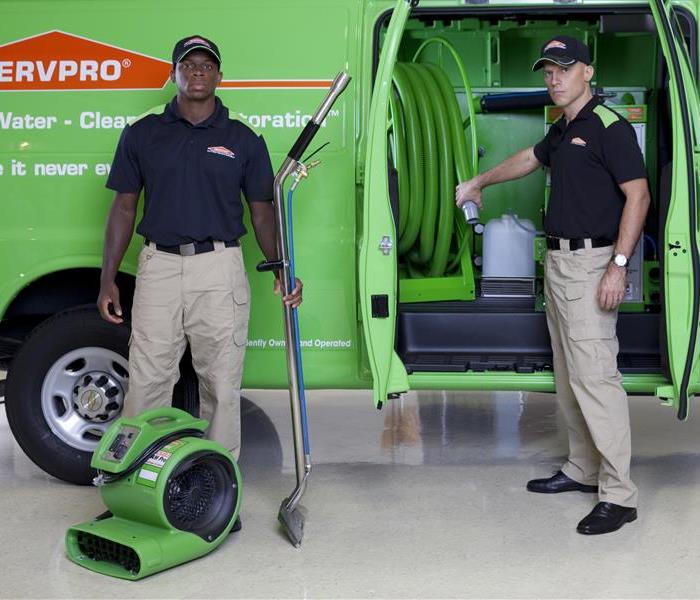 Washington, MO Mold Damage Remediation Professionals
Washington, MO Mold Damage Remediation Professionals
Professional Mold Damage Remediation in Washington, MO
All it takes is excess humidity or a small water leak for mold damage in Washington, MO to form in your home or business. Mold spores can produce harmless allergens, irritants, and other minor health effects. The first step in addressing any growth is to identify and manage the source. If moisture problems are not addressed, then any fungi cleanup or removal will only be a short-term solution. At some point, this type of growth will return.
Here are some interesting mold facts and myths:
• How many types of mold are there? There are more than 100,000 types and species of mold. The common types of home and office mold species are Cladosporium, Penicillium, Aspergillus, and Alternaria.
• Can mold can only grow around pipes, leaks or because of floods? Mold does not grow on surfaces that are directly affected by water. Mold spores often occur within the HVAC systems of buildings and homes. They can grow on any surface that has its ideal environment, moisture, and humidity.
• Is black mold worse than other molds? Mold growth comes in a range of colors. Many molds classified black are actually a very dark green. Black mold is not necessarily more dangerous than other species of mold.
• Can this fungus cause skin rashes? The CDC reports that exposure to molds doesn’t contribute to rashes.
• Can I clean mold to eliminate it? Mold can become latent and reactivate. Tiny mold spores replicate every 24 hours, thus often growing back. For porous materials, like ceiling tiles, carpeting, wood, paper, and drywall, surface cleaning is often not enough.
If you see signs of mold damage in your Washington, MO home or business don't put out the for sale sign. Instead, contact SERVPRO of Franklin County. As a trusted leader in the restoration industry, SERVPRO of Franklin County provides 24-hour residential and commercial services. As a locally owned and operated business, we’re dedicated to being faster to any size disaster, with the training, equipment, and expertise to handle your restoration and cleaning needs. If you would like to schedule service for your home or business, please call today! 636-583-5200
Tips to Control Moisture in your Franklin County, MO Home
8/5/2016 (Permalink)
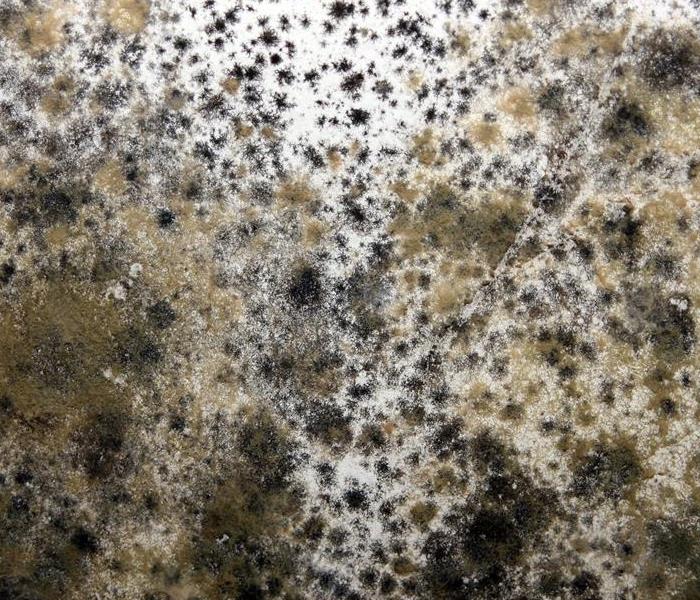 Mold & Moisture Control - Franklin County, MO SERVPRO
Mold & Moisture Control - Franklin County, MO SERVPRO
Extra moisture in your Franklin County, MO home can cause damage and encourage harmful mold and mildew growth.
Learn how to reduce moisture and prevents the problems with these tips.
Activities such as cooking, bathing, and dish washing can add moisture into the air. Even some heating appliances can cause additional humidity in your home, for example: unvented gas or kerosene models. Droplets can accumulate on common cool surfaces during the winter, such as windows, walls, and doors that lack proper insulation. This can cause rot and peeling of paint, and also a good environment for mold growth.
If you happen to see moisture accumulating, be sure to dry it promptly. Be sure to take care of the issue that is causing the moisture.
Storm doors and windows can minimize cool surfaces in the winter by separating the interior from cold air outside. Upgrading your windows to double and triple pane can also help insulate the interior glass. This will also make your home more energy efficient.
Opening drapes and blinds in the winter allows warmth to the interior glass. Some condensation can occur, but the improved circulation makes it less probable to accumulate. Insulating cold-water pipes eliminates a common cool surface.
Bathroom exhaust fans, dryer exhaust and ducted kitchen exhaust hoods that vent to the outside remove moisture that some activities create. Keep the devices free of dust, lint, grease or anything that could keep them from working efficiently.
Other ways to reduce air moisture:
•Covering pots while cooking, when possible
•Leaving room doors open to allow good air circulation
•Storing firewood outside
•Covering aquariums
Moisture in the home is not always as obvious as water beading on a window. Poor ventilation in an attic can result in condensation, promoting mold growth in the framing elements of the house. A sealed, unused fireplace creates an opportunity for moisture problems. If air doesn't circulate in the fireplace, condensation can accumulate on the walls and soak into the masonry. If you have a crawlspace, moisture from the soil can enter your home, increasing the level of humidity. A vapor barrier over the bare soil blocks the moisture.
Rain that seeps into your home's foundation can lead to moisture problems. Make sure your gutters work properly and direct water away from your home's foundation.
Some moisture problems require more complex solutions, and sources of moisture may be hidden. It may be time to call a professional like SERVPRO. Extra moisture in your home can cause mold. Mold can produce allergens and irritants so if you suspect you have a mold issue, you should call us to inspect your Franklin County, MO home. We are trained mold damage specialists who get started quickly to get your Franklin County, MO home (or business) back to normal, with specific training and certifications to handle your restoration needs.
If You See Signs of Mold, Call Us Today – (636) 583-5200
Mold Damage Tips for Franklin County, MO
6/7/2016 (Permalink)
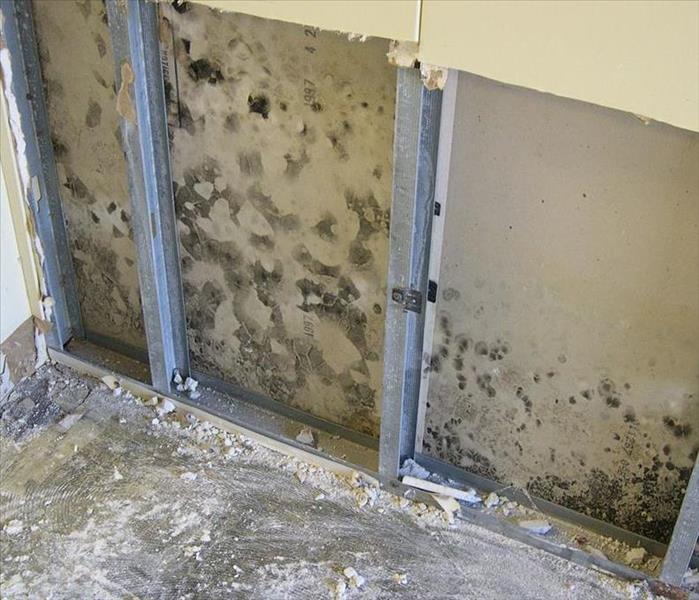 Franklin County, MO Mold Damage
Franklin County, MO Mold Damage
Do you have mold in your Franklin County, MO home or business?
Here are some important things to keep in mind as you start remediation.
- Take care of any water damage quickly. Mold can occur in just 48 hours, so a fast response is vital. Drying all wet material is also critical.
- Absorbent or porous materials such as ceiling tiles and carpet may need to be thrown out. It’s almost impossible to remove mold from porous materials completely.
- Avoid exposing yourself and others to mold. PPE is required.
- Do not paint or caulk moldy surfaces.
Hidden Mold
You may suspect hidden mold if your Franklin County, MO home smells moldy, or if you know there has been water damage and there are been reports of health issues. There can be mold hidden away in places such as the backside of dry wall, wallpaper, paneling, the top side of ceiling tiles, carpet and pads, etc. Other hidden places can be the inside walls around pipes, the surface of walls behind furniture, inside ductwork, and in roof materials above ceiling tiles.
Investigating hidden mold can be difficult. It will often require caution when the investigation involces distrucing sites of mold growth. An example of this would be removing wallpaper. This can lead to a massive release of spores if there is mold growing on the underside of the paper.
If you believe you have a mold problem, it is best to have a professional get involved. Mold can produce allergens and irritants and has the potential to cause other health effects.
The Mold Remediation Process
Every mold damage scenario is different, and requires a unique solution, but the general mold remediation process stays the same. The steps listed below illustrate the SERVPRO “typical” process:
- Emergency Contact - (636) 583-5200
- Inspection and Mold Damage Assessment
- Mold Containment
- Air Filtration
- Removing Mold and Mold-Infested Materials
- Cleaning Contents and Belongings
- Restoration
SERVPRO of Franklin County can assess the mold damage in your Franklin County, MO home. We offer highly trained technicians, specialized mold remediation equipment, and are a trusted leader in the restoration industry.
If You See Signs of Mold, Call Us Today – (636) 583-5200
What Mold Specialists Do After a Flood
5/20/2016 (Permalink)
Have you ever wondered what happens when a mold removal specialist gets called to a mold-damaged facility? The Institute of Inspection, Cleaning and Restoration Certification (IICRC) shares below five steps a mold-removal specialist takes when conducting mold remediation.
“Many people aren’t aware of the dangers or the difficulty level of removing mold from a facility,” said IICRC Chairman Tony Wheelwright. “Mold remediation is a potentially hazardous process that should only be undertaken by a certified professional.”
Five steps each mold-removal specialist takes when conducting mold remediation include:
1. Determine the degree of contamination
The first step for a mold remediation specialist may be to bring in an Indoor Environmental Professional (IEP) to determine the extent of the mold damage and test for contamination within the facility.
Because mold spores and other microscopic contaminants can travel easily throughout a building, the IEP may collect and analyze samples from affected, as well as unaffected, areas of the building. Once the IEP has finished the inspection they will develop a remediation plan for the mold-removal specialist with steps to return the home to its pre-loss condition (Condition 1).
2. Set up and verify the containment
To make sure mold contamination does not spread to other areas of a facility, the mold-remediation specialist will set up containment by creating isolation barriers.
Once the barriers are set up, the specialist will need to verify the containment with a lower partial pressure differential (negative pressure) to ensure there is no air leakage between containment zones.
Exit chambers will then be used to serve as a transition between the containment and the unaffected area of the building. Once the containment is verified and the correct amount of pressure is achieved, the removal process can begin.
3. Remove unsalvageable materials
Porous materials and items that cannot be restored or cleaned effectively must be carefully discarded. Unsalvageable items include, but are not limited to, drywall, insulation and other items with visible mold growth.
It is important for the specialist to wear the appropriate personal protective equipment (PPE), which may include a full face respirator equipped with a P100/OV cartridge, disposable coveralls and nitrile gloves.
4. Clean surfaces with a high attention to detail
A mold-remediation specialist will likely begin the cleaning process by thoroughly vacuuming the contaminated areas using a HEPA vacuum with a high efficiency filter to catch mold spores. He or she will then begin a detailed cleaning process involving mold removal tools such as a HEPA-filtered sander followed by the damp wiping of surfaces with an effective cleaning solution.
5. Verify remediation
Once cleaning is complete, the IEP will return to verify the remediation was successful. The area must be returned to the dry standard and should be visually dust free with no malodors.
In addition, an IEP may perform surface or air sampling as part of the verification that the area is back to normal fungal ecology (Condition 1).
“Mold remediation requires mold removal specialists to perform techniques that promote source removal rather than relying on chemicals, paints and coatings as a replacement,” said Rachel Adams, President of Indoor Environmental Management Inc. “Understanding and managing air flow is also critical to the success of a mold remediation project. Working with qualified IEP can also help to reduce the liability for the technician as well as provide a final determination if the remediation was successful.”
SERVPRO of Franklin County - We’re Highly Trained Mold Remediation Specialists
Mold can produce allergens and irritants and has the potential to cause other health effects. Mold can spread quickly through your Franklin County, MO home or business in as little as 48 hours. If you suspect that your home or business has a mold problem, we can inspect and assess your property. If mold is found, we have the training, equipment, and expertise to remediate your mold infestation.
Learn more about mold and what to do until help arrives by reviewing these mold damage tips.
If You See Signs of Mold, Call SERVPRO of Franklin County Today – (636) 583-5200
Source:
http://www.cleanfax.com/restoration/what-mold-specialists-do-after-a-flood/
Flood Cleanup: Avoiding Indoor Air Quality Problems
1/20/2016 (Permalink)
During a flood cleanup, the indoor air quality in your home or office may appear to be the least of your problems. However, failure to remove contaminated materials and to reduce moisture and humidity can present serious long- term health risks. Standing water and wet materials are a breeding ground for microorganisms, such as viruses, bacteria, and mold. They can cause disease, trigger allergic reactions, and continue to damage materials long after the flood.
Avoid Problems from Microbial Growth
Remove Standing Water
Standing water is a breeding ground for microorganisms, which can become airborne and be inhaled. Where floodwater contains sewage or decaying animal carcasses, infectious disease is of concern. Even when flooding is due to rainwater, the growth of microorganisms can cause allergic reactions in sensitive individuals. For these health reasons, and to lessen structural damage, all standing water should be removed as quickly as possible.
Dry Out Your Home
Excess moisture in the home is an indoor air quality concern for three reasons:
• Microorganisms brought into the home during flooding may present a health hazard. These organisms can penetrate deep into soaked, porous materials and later be released into air or water. Coming in contact with air or water that contains these organisms can make you sick.
• High humidity and moist materials provide ideal environments for the excessive growth of microorganisms that are always present in the home. This may result in additional health concerns such as allergic reactions.
• Long-term increases in humidity in the home can also foster the growth of dust mites. Dust mites are a major cause of allergic reactions and asthma.
Remove Wet Materials
It can be difficult to throw away items in a home, particularly those with sentimental value. However, keeping certain items that were soaked by water may be unhealthy. Some materials tend to absorb and keep water more than others. In general, materials that are wet and cannot be thoroughly cleaned and dried within 24-48 hours should be discarded, as they can remain a source of microbial growth.
Avoid Problems from the Use of Cleaners and Disinfectants
The cleanup process involves thorough washing and disinfecting of the walls, floors, closets, shelves, and contents of the house. In most cases, common household cleaning products and disinfectants are used for this task. FEMA also suggests the use of disinfectants and sanitizers on the ductwork for the heating and air conditioning system, if it has been flooded.
Disinfectants and sanitizers contain toxic substances. The ability of chemicals in other household products used for cleaning to cause health effects varies greatly, from those with no known health effect to those that are highly toxic. Read and follow label instructions carefully, and provide fresh air by opening windows and doors. If it is safe for you to use electricity and the home is dry, use fans both during and after the use of disinfecting, cleaning, and sanitizing products.
Be careful about mixing household cleaners and disinfectants together. Check labels for cautions on this. Mixing certain types of products can produce toxic fumes and result in injury and even death.
Avoid Problems from Airborne Asbestos and Lead Dust
Elevated concentrations of airborne asbestos can occur if asbestos-containing materials present in the home are disturbed. Airborne asbestos can cause lung cancer and mesothelioma, a cancer of the chest and abdominal linings.
Lead is a highly toxic metal which produces a range of adverse health effects, particularly in young children. Disturbance or removal of materials containing lead-based paint may result in elevated concentration of lead dust in the air.
(Source: http://www.epa.gov/sites/production/files/2015-09/documents/floods.pdf)
Have a professional inspect your home or business
Why Choose SERVPRO of Franklin County?
24-Hour Emergency Service
Faster to Any Size Disaster
Highly Trained Mold Remediation Technicians
Specialized Mold Remediation Equipment
A Trusted Leader in the Restoration Industry
Locally Owned and Operated
Any home or commercial property can quickly become infested with mold if a source of water is present. Mold can spread throughout a property in as little as 48 hours. Since mold can produce allergens and irritants, you should call us to inspect your Union home if you suspect you have a mold problem. If mold is found, we have the training, equipment, and expertise to remediate your mold infestation.
Learn more about mold and what to do until help arrives by reviewing these mold damage tips.
We’re Faster to Any Size Disaster
A minor mold problem can quickly become a major infestation if left untreated. We can start the remediation process immediately after you contact us. A faster response lessens the mold damage, limits additional damage, and reduces the remediation cost. Learn More
We’re Highly Trained Mold Remediation Specialists
As water and mold damage specialists, we have the experience, the expertise, and the advanced training that enables us to get your property restored quickly and thoroughly.
Applied Microbial Remediation SpecialistWater Damage Restoration TechnicianApplied Structural Drying TechnicianLearn More
We Use Advanced Mold Remediation Techniques and Equipment
Our advanced equipment helps to detect and stop the source of water feeding the mold. We then isolate the affected area using a negative air pressure chamber. Learn More
Locally Owned Company with National Resources
We live and work in this community too; we might even be neighbors. As a locally owned and operated business, SERVPRO of Franklin County is close by and ready to help with your mold-damaged property. We are proud to be an active member of the Franklin County, MO community and want to pitch in and help make our community the best it can be.
When a major storm or event occurs, we can call upon our national network of 1,650 SERVPRO Franchises and special Disaster Recovery Teams if we need additional resources or personnel.
MOLD PREVENTION TIPS
12/21/2015 (Permalink)
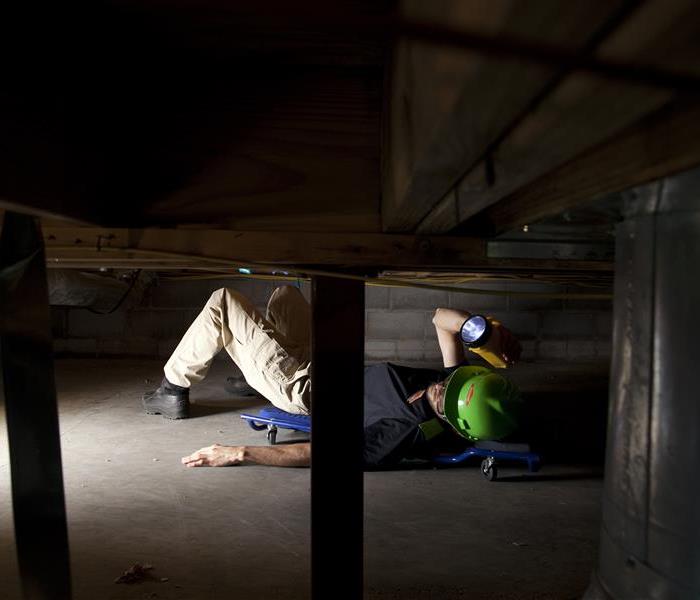
- Keep humidity levels as low as you can—no higher than 50%--all day long. An air conditioner or dehumidifier will help you keep the level low. Bear in mind that humidity levels change over the course of a day with changes in the moisture in the air and the air temperature, so you will need to check the humidity levels more than once a day.
- Be sure your home has enough ventilation. Use exhaust fans which vent outside your home in the kitchen and bathroom. Make sure your clothes dryer vents outside your home.
- Fix any leaks in your home’s roof, walls, or plumbing so mold does not have moisture to grow.
- Clean up and dry out your home thoroughly and quickly (within 24–48 hours) after flooding.
- Add mold inhibitors to paints before painting.
- Clean bathrooms with mold-killing products.
- Remove or replace carpets and upholstery that have been soaked and cannot be dried promptly. Consider not using carpet in rooms or areas like bathrooms or basements that may have a lot of moisture.
- To learn more about preventing mold in your home, see the Environmental Protection Agency's publication A Brief Guide to Mold, Moisture, and Your Home at http://www.epa.gov/mold/moldguide.html.
The Mold Remediation Process
Every mold infestation is different, from the amount of mold to the types of materials affected. Each scenario requires a unique solution, but the general process stays the same. The steps listed below illustrate our process for a “typical” mold remediation infestation:
- Emergency Contact - (636) 583-5200
- Inspection and Mold Damage Assessment
- Mold Containment
- Air Filtration
- Removing Mold and Mold-Infested Materials
- Cleaning Contents and Belongings
- Restoration
Common Mold Misconceptions
It’s easy to understand why many people struggle to grasp the facts and issues surrounding indoor mold because sensational news stories and advertising cloud and obscure the real issues. Educate yourself with the facts about mold and learn about the mold remediation process.
Locally Owned Company with National Resources
We live and work in this community too; we might even be neighbors. As a locally owned and operated business, SERVPRO of Franklin County is close by and ready to help with your mold-damaged property. We are proud to be an active member of the Union community and want to pitch in and help make our community the best it can be.
When a major storm or event occurs, we can call upon our national network of 1,650 SERVPRO Franchises and special Disaster Recovery Teams if we need additional resources or personnel.
Facts about Mold and Dampness
12/21/2015 (Permalink)
Facts about Mold and Dampness
There is always some mold everywhere - in the air and on many surfaces. Molds have been on the Earth for millions of years. Mold grows where there is moisture.
Mold and Your Health
Exposure to damp and moldy environments may cause a variety of health effects, or none at all. Some people are sensitive to molds. For these people, molds can cause nasal stuffiness, throat irritation, coughing or wheezing, eye irritation, or, in some cases, skin irritation. People with mold allergies may have more severe reactions. Immune-compromised people and people with chronic lung illnesses, such as obstructive lung disease, may get serious infections in their lungs when they are exposed to mold. These people should stay away from areas that are likely to have mold, such as compost piles, cut grass, and wooded areas.
In 2004 the Institute of Medicine (IOM) found there was sufficient evidence to link indoor exposure to mold with upper respiratory tract symptoms, cough, and wheeze in otherwise healthy people; with asthma symptoms in people with asthma; and with hypersensitivity pneumonitis in individuals susceptible to that immune-mediated condition. The IOM also found limited or suggestive evidence linking indoor mold exposure and respiratory illness in otherwise healthy children.
Mold and Your Home
Mold is found both indoors and outdoors. Mold can enter your home through open doorways, windows, vents, and heating and air conditioning systems. Mold in the air outside can also attach itself to clothing, shoes, bags, and pets can and be carried indoors.
Mold will grow in places with a lot of moisture, such as around leaks in roofs, windows, or pipes, or where there has been flooding. Mold grows well on paper products, cardboard, ceiling tiles, and wood products. Mold can also grow in dust, paints, wallpaper, insulation, drywall, carpet, fabric, and upholstery.
You Can Control Mold
Inside your home you can control mold growth by:
Controlling humidity levels;
Promptly fixing leaky roofs, windows, and pipes;
Thoroughly cleaning and drying after flooding;
Ventilating shower, laundry, and cooking areas.
If mold is growing in your home, you need to clean up the mold and fix the moisture problem.
Mold growth, which often looks like spots, can be many different colors, and can smell musty. If you can see or smell mold, a health risk may be present. No matter what type of mold is present, you should remove it. The best practice is to remove the mold and work to prevent future growth.
The Mold Remediation Process
Every mold infestation is different, from the amount of mold to the types of materials affected. Each scenario requires a unique solution, but the general process stays the same. The steps listed below illustrate our process for a “typical” mold remediation infestation:
- Emergency Contact - (636) 583-5200
- Inspection and Mold Damage Assessment
- Mold Containment
- Air Filtration
- Removing Mold and Mold-Infested Materials
- Cleaning Contents and Belongings
- Restoration
Common Mold Misconceptions
It’s easy to understand why many people struggle to grasp the facts and issues surrounding indoor mold because sensational news stories and advertising cloud and obscure the real issues. Educate yourself with the facts about mold and learn about the mold remediation process.
Locally Owned Company with National Resources
We live and work in this community too; we might even be neighbors. As a locally owned and operated business, SERVPRO of Franklin County is close by and ready to help with your mold-damaged property. We are proud to be an active member of the Union community and want to pitch in and help make our community the best it can be.
When a major storm or event occurs, we can call upon our national network of 1,650 SERVPRO Franchises and special Disaster Recovery Teams if we need additional resources or personnel.
Ten Things You Should Know about Mold
12/21/2015 (Permalink)
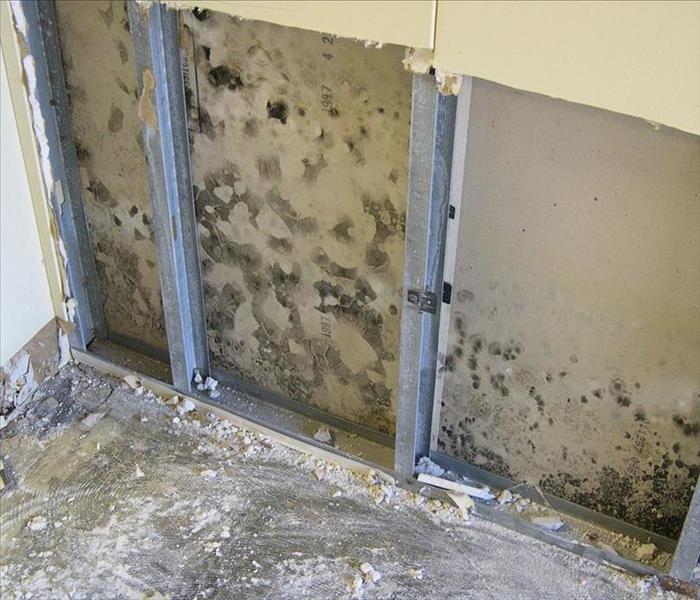
- Potential health effects and symptoms associated with mold exposures include allergic reactions, asthma and other respiratory complaints.
- There is no practical way to eliminate all mold and mold spores in the indoor environment; the way to control indoor mold growth is to control moisture.
- If mold is a problem in your home or school, you must clean up the mold and eliminate sources of moisture.
- Fix the source of the water problem or leak to prevent mold growth.
- Reduce indoor humidity (to 30-60%) to decrease mold growth by:
-Venting bathrooms, dryers and other moisture-generating sources to the outside
-Using air conditioners and de-humidifiers
-Increasing ventilation
-Using exhaust fans whenever cooking, dishwashing and cleaning - Clean and dry any damp or wet building materials and furnishings within 24-48 hours to prevent mold growth.
- Clean mold off hard surfaces with water and detergent, and dry completely. Absorbent materials such as ceiling tiles, that are moldy, may need to be replaced.
- Prevent condensation: Reduce the potential for condensation on cold surfaces (i.e., windows, piping, exterior walls, roof, or floors) by adding insulation.
- In areas where there is a perpetual moisture problem, do not install carpeting (i.e., by drinking fountains, by classroom sinks, or on concrete floors with leaks or frequent condensation).
- Molds can be found almost anywhere; they can grow on virtually any substance, providing moisture is present. There are molds that can grow on wood, paper, carpet, and foods.
Source: cdc.gov/moldThe Mold Remediation Process
Every mold infestation is different, from the amount of mold to the types of materials affected. Each scenario requires a unique solution, but the general process stays the same. The steps listed below illustrate our process for a “typical” mold remediation infestation:
- Emergency Contact - (636) 583-5200
- Inspection and Mold Damage Assessment
- Mold Containment
- Air Filtration
- Removing Mold and Mold-Infested Materials
- Cleaning Contents and Belongings
- Restoration
Common Mold Misconceptions
It’s easy to understand why many people struggle to grasp the facts and issues surrounding indoor mold because sensational news stories and advertising cloud and obscure the real issues. Educate yourself with the facts about mold and learn about the mold remediation process.
Locally Owned Company with National Resources
We live and work in this community too; we might even be neighbors. As a locally owned and operated business, SERVPRO of Franklin County is close by and ready to help with your mold-damaged property. We are proud to be an active member of the Union community and want to pitch in and help make our community the best it can be.
When a major storm or event occurs, we can call upon our national network of 1,650 SERVPRO Franchises and special Disaster Recovery Teams if we need additional resources or personnel.
Mold Basics
9/24/2015 (Permalink)
Mold Basics
-The key to mold control is moisture control.
-If mold is a problem in your home, you should clean up the mold promptly and fix the water problem.
-It is important to dry water-damaged areas and items within 24-48 hours to prevent mold growth.
Why is mold growing in my home?
Molds are part of the natural environment. Outdoors, molds play a part in nature by breaking down dead organic matter such as fallen leaves and dead trees, but indoors, mold growth should be avoided. Molds reproduce by means of tiny spores; the spores are invisible to the naked eye and float through outdoor and indoor air. There are many types of mold, and none of them will grow without water or moisture.
Moisture and Mold Prevention and Control Tips
-When water leaks or spills occur indoors - ACT QUICKLY. If wet or damp materials or areas are dried 24-48 hours after a leak or spill happens, in most cases mold will not grow.
-Clean and repair roof gutters regularly.
-Make sure the ground slopes away from the building foundation, so that water does not enter or collect around the foundation.
-Keep air-conditioning drip pans clean and the drain lines unobstructed and flowing properly.
-Keep indoor humidity low. If possible, keep indoor humidity below 60 percent (ideally between 30 and 50 percent) relative humidity. Relative humidity can be measured with moisture or humidity meter, a small, inexpensive ($10-$50) instrument available at many hardware stores.
-If you see condensation or moisture collecting on windows, walls or pipes ACT QUICKLY to dry the wet surface and reduce the moisture/water source. Condensation can be a sign of high humidity.
Bathroom Tip
Places that are often or always damp can be hard to maintain completely free of mold. If there’s some mold in the shower or elsewhere in the bathroom that seems to reappear, increasing ventilation (running a fan or opening a window) and cleaning more frequently will usually prevent mold from recurring, or at least keep the mold to a minimum.


 24/7 Emergency Service
24/7 Emergency Service













